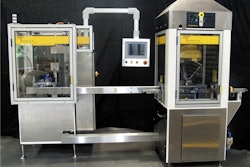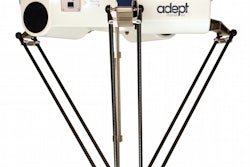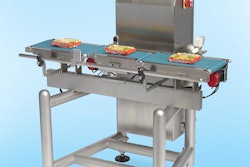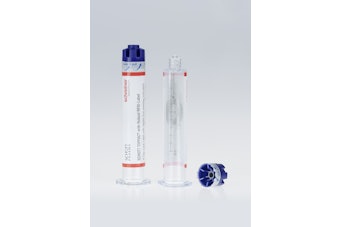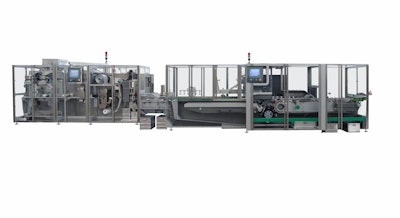
Marchesini Group introduces the new robotized integrated blister line, Integra 520V. The line, which features a balcony design and is 10-m long, combines two machines: a thermoformer (520 blisters/min in Alu+PVC/PVDC/PET/Alu/other materials) and a cartoner (500 cartons/min with tuck-in or glued flap closure and various other combinations).
Integra 520V features the functions of Integra 320, plus new pushers, a drum-type carton opener for high speeds, and a new leaflet pick-and-place system. The final result is a machine for single-blister cartons that is easy to clean and change over size with a product feeding area that’s separate from the electrical and mechanical area. All the mechanisms are in oil bath so they are more resistant to wear and tear and long-lasting.
The reels of forming material are arranged in a compartment at the back of the machine but can also be installed at the front of the machine, if requested. There are transparent guards to protect them against dust. Reel unwinding is automatic, servo-driven, and stops when the film runs out. A splicing table with automatic web-grip vacuum keeps the film in the right position and allows the technician to quickly join the new reel with the old one. The lidding reel (maximum diameter 300 mm) is located at the front of the machine, and has an automatic splicing table to make reel replacement easier.
The thermoforming station is arranged at the back of the machine so that the overall footprint is more compact, and the technician is better protected from the forming material fumes. The forming material loading area and the machine feeding station are completely separate, reducing the area with modified atmosphere and minimizing costs.
The material is formed in three different ways: by compressed air for PVC, PVDC, and ACLAR; by air and plug assist for difficult-to-shape plastic; and by a mechanical solution of forming dies for aluminum.
A servo-driven transfer roller positions the forming material correctly for the infeed stroke, which is adjusted automatically without the use of tools. The servo-driven heating plates open automatically if the machine stops so as not to strain the film.
The machine can be equipped with different product feeders, according to the product specifications and the manufacturing procedures involved: high-speed feeder with patented release system by Pulsar, Universal, and Multiplex. The machine is flexible as its feeding station can be built to accommodate two different loading systems in the same area: Universal+HS or Multiplex+Universal, using the designed changeover parts.
Regardless of the feeder chosen, the machine is designed so that it can be easily dismantled without tools, thanks to the use of quick-release parts. The feeding station is equipped with a dust-extraction system with fragment separation.
The flat sealing station works with combined intermittent and continuous motion. The horizontal intermittent motion follows the continuous motion of the forming web so that it seals even at low temperatures by extending the sealing time and keeping the sealing pressure uniform over the whole surface area of the blister. Should the machine stop, the upper sealing block opens automatically to protect the web, the lid foil, and the product. Cooling plates cool the web just after sealing.
The blisters are coded by cold punches and cut in the same station. A servo-driven rubber unwinding roller transfers the blisters to the cutting station, while cameras check they are centered. The cutter can be changed easily and without the use of tools. The perforating station is optional and is placed above the cutting station on a separate module. Once cut, the blisters are picked up and placed directly onto the conveyor belt of the Robocombi. The waste is discarded into separated containers.
The three-axes Robocombi feeds the blisters into the bucket belt of the cartoning machine and can be programmed for different stacking heights, based on the preset blister count. It is managed by automatic synchronization software of the transfer, tracking, and stacking system. There is also a manual loading station to reinstate missing blisters on the toothed belt.
The two sections of the line (blister thermoformer and cartoner) can be separated by a wall so that they can be installed in rooms with different classifications and can work separately, according to the customer’s needs.
The capacious carton magazine is arranged in an ergonomic and strategic position under the product conveyor belt in order to avoid dust over the blisters and to ease carton loading for operators. A drum picks up the cartons and opens them out, holding them firmly and accurately even at high speeds. The cartons are then taken directly to the carton conveyor belt. Access to the forepart of the machine has been improved, allowing operators a better overview of the whole machine.
The carton conveyor belt is silent, even at high speeds, and is easy to keep clean. Two pushing fingers and two guiding fingers on the belt hold the cartons firmly and securely while the product is inserted and throughout the whole process. The belt is durable and easy to replace.
The leaflet-feeding unit is enclosed by guards to minimize noise. The GUK feeding unit is in an ergonomic position (lower than the previous models) to ease leaflet loading. In view of the high processing speeds involved, a new rotating pick-and-place unit was designed and installed to transfer the leaflets to the pushers.
Two separate combined units, a pusher and blade, insert the product into the carton with precision, even at high speeds. A simple input from the display raises the unit automatically when the machine has to be cleaned or serviced. The machine is designed to handle various carton closures: tuck-in, alternated or even flap, fourth flap, etc. The changeover parts are manufactured in blocks to make changeover quicker and easier, even for inexperienced workers.



